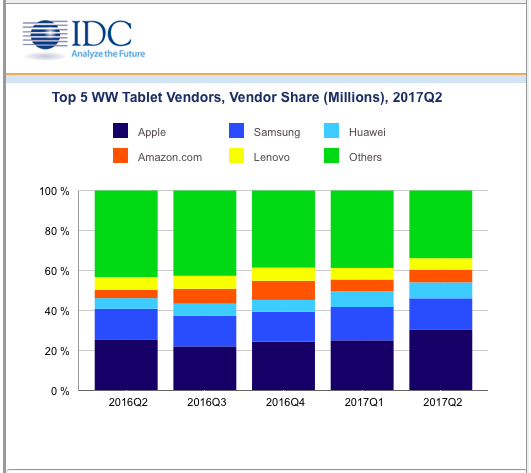Value-Priced $329 Model Stimulates Return To iPad Sales Growth – The ‘Book Mystique
The tide finally turned on the three year long iPad sales slump in 2017’s second calendar quarter (Apple’s fiscal 2017 third quarter) that ended July 1, 2017. Apple’s financial results announced on August 1 report iPad sales of more than 11.4 million units in the quarter, representing a substantial 14.7 percent year-over-year increase in units shipped. The robust turnaround also increased Apple’s share of the overall tablet market to 30.1 percent — up nearly five points over the company’s 25.4 percent share in its 2016 third quarter according to the market analysis firm International Data Corporation (IDC)’s Worldwide Quarterly Tablet Tracker. The iPad’s growth was particularly noteworthy in the context of a 3.4 percent year-over-year decline in worldwide tablet shipments overall in calendar 2Q17.

Despite the impressive increase in numbers of units shipped, iPad revenues increased by only a modest two percent year-over-year in the quarter, and while Apple doesn’t include a model-by-model sales breakdown in its financial results, the figures incline one to deduce that most of the growth was attributable to the new $329 base 9.7-inch iPad ( AKA iPad 5) released in March.
We’ll have to wait for Apple’s fiscal fourth quarter results in October for clearer indication of the impact the new A10X Fusion chipset powered 10.5-inch iPad Pro and refresh of the 12.9-inch Pro model announced at the World Wide Developer’s Conference in June are having on Apple’s iPad profit margins, since these units only began reaching customers about two weeks before Apple’s Q317 period ended.
Back in March I pronounced Apple’s strategy with the $329 entry level iPad “brilliant,” finally making an Apple tablet price-competitive with mid-pack Android and Windows tablet offerings, and predicted the value price should also put Apple back in contention in the education market (the base iPad is priced at $309 at the education store) where it has been getting squeezed out by inexpensive Chromebooks.
However, keeping it real, this iPad is no fifty-dollar Amazon slate. Customary iPad quality of engineering, materials, polished workmanship and tight integration of the hardware with the iOS operating system are all there, and its A9 power, while not state of the art, should keep the $329 iPad in contention for some time to come. In my estimation it represents the greatest value Apple has ever offered in an iPad for folks who don’t mind saving significant up-front expense by using mature but still very robust technology. Evidently, a sizable cohort agrees with my assessment. IDC notes that the $329 9.7-inch iPad’s relatively low price point persuaded some consumers to upgrade their aging iPads, with demand for this model resulting in a breakthrough turnaround at last in what had seemed like a relentless decline in Apple’s iPad business since 2014. However, IDC warns that such gains may be temporary, with the replacement cycle of tablets still long (closer to that of traditional PCs than smartphones), and that first-time buyers have become a rare commodity.
My initial take on the $329 iPad was that it amounted to an upgrade of the iPad Air 2 it replaced in Apple’s iPad lineup — the “iPad Air 3” if you will. However, further investigation revealed that it is really more an “iPad Air 2 1/2” or an upgrade of the original iPad Air, with which it shares a slightly thicker housing form factor.
The $329 iPad has a 64-bit A9 processor with embedded M9 motion coprocessor system-on-chip, compared with the A8X chipset in my iPad Air 2, although the real world performance difference is not dramatic. However, it does not have the Air 2’s fully laminated display with anti-glare coating, presumably an omission to help cut OEM cost in making a price slash as radical as they did with this unit. In addition to the faster silicon, the new iPad’s greater battery capacity — 32.9Wh versus the Air 2’s 27.6Wh — does appeal, and I would gladly trade some thinness (in general across all of Apple’s system lines) for longer battery life and more connectivity features.
If you’re still using an original iPad Air or something older, the value-leader iPad will be a very satisfying upgrade from what you’re using now, and if you’re in the hunt for your first iPad, the $329 is pretty much a no-brainer unless you’d sooner have an iPad mini. I would suggest going with the 128GB memory upgrade if you can handle the extra cash outlay.
Most buyers of the $329 model are probably not very interested in Apple Pencil stylus or Smart Keyboard Smart Connector type Keyboard support (and their associated extra cost), but if you are, Apple will gladly sell you a 10.5-inch or 12.9-inch iPad Pro.
